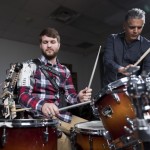 Earlier this year I wrote about a new robotic prosthetic that was capable of reading the mind of its wearer. The device is implanted into the bone at the end of the residual limb and allows patients to use the arm without any kind of harness.
Earlier this year I wrote about a new robotic prosthetic that was capable of reading the mind of its wearer. The device is implanted into the bone at the end of the residual limb and allows patients to use the arm without any kind of harness.
A team from Georgia Institute of Technology showcased the tremendous potential of such a device in a recent project that attached a ‘smart arm’ to the shoulder of a musician and allowed them to essentially play the drums with three arms.
The robotic arm, which was attached to the shoulder of the drummer, was capable of responding to the movements of the player.
“If you augment humans with smart, wearable robotics, they could interact with their environment in a much more sophisticated manner,” the team say. “The third arm provides a much richer and more creative experience, allowing the human to play many drums simultaneously with virtuosity and sophistication that are not otherwise possible.”
Smart drumming
The robotic arm is capable of adjusting its movements based upon the music it ‘hears’ being played. So if the drummer is playing slowly, the robotic arm slows its own playing, and vice versa.
Throw this in with an ability to understand its location, both in relation to the drum kit itself and the human drummer, and you have an intelligent device capable of augmenting what the drummer is doing.
The device was developed out of a project to provide a prosthetic limb for a drummer in the US.
“If you have a robotic device that is part of your body, it’s a completely different feeling from working alongside a regular robot,” the team say. “The machine learns how your body moves and can augment and complement your activity. It becomes a part of you.”
Connecting it up
As with the prosthetic limb mentioned at the start of this post, the next stage is to link the movement of the arm with the brain activity of the wearer. They have already tinkered with an EEG headband that will detect the brain activity of the wearer with the hope being that patterns will emerge that will allow them to develop the arm to respond accordingly.
Suffice to say, whilst this is pretty cool in a drumming context, the team believe it will also have numerous applications in other environments. For instance, they envision medics being able to use the device to help them in surgery.
At the moment though, music is proving a good test ground to fine tune the delicate movements required to make the right sounds at the right time.
It will certainly be a project that’s worth keeping an eye on.